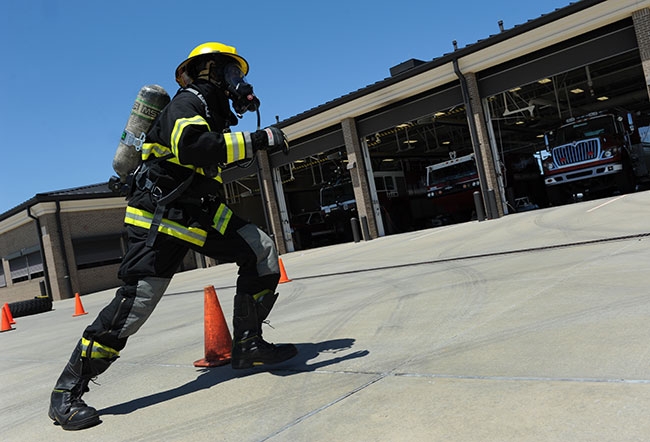
Fit for Duty: How to improve strength and endurance
Sherry Dean
Features Fitness Health and Wellness annex canadian firefighter fitnessWell-rounded firefighters are more than strong. If the elevator doesn’t work and you don’t have the endurance to climb the 15 storeys, the fact you have the strength to smash in the door is irrelevant. Being able to sprint through two kilometres of woods to get to a brush fire is fruitless if you can’t carry the pump and supplies. There are many benefits of developing a combination of strength and endurance. You can and need to do both.
 Columnist Sherry Dean says firefighters need to build both strength and endurance to be fit for duty.
Columnist Sherry Dean says firefighters need to build both strength and endurance to be fit for duty.A colleague once commented on the rep scheme of a particular workout, which had a very high rep count. He argued that doing 30, 40 or even 50 reps of an exercise would be detrimental and could even lead to injury. I asked him if he had ever chopped a cord of wood and then asked if he had been able to do it in 12 chops. Point taken.
There is no question that repetitive trauma injuries happen, but they are usually the result of improper form and conditioning. There are easy ways to avoid overuse injuries while increasing your intensity and stamina. Balancing your ability to complete movements without compromising form and pacing your intensity is key. Changing your reps from low (one to five) to high (20 and above), and including a variety of exercise movements will also help to limit the possibility of injury.
Mix up your workout routine to include days where you perform heavy lifting, days where you do more endurance-based work and days that combine the two. This schedule will improve both facets of your fitness. There are countless approaches to programming, but you don’t have to get overwhelmed by the choices. Focus on your personal needs. If you have a weak upper body, then spend more time on upper body strength development. Just don’t forget about endurance. Be sure to include high-rep days periodically. The same holds true for any other body part.
Include high-intensity movements in your workout. These movements do not have to be high-impact. Slamming a medicine ball and kettlebell swings are two examples of low-impact movements that will quickly elevate your heart rate and challenge strength at the same time. Rowing is another fabulous exercise you can use for power and intensity. My all-time favourite heart rate movement – burpees!
Monitor your intensity. Don’t let your form suffer. If you have to start cheating to do an exercise, take a short rest. Rest long enough to recover, but not so long that you aren’t challenged by the workout. Take a three to five second rest and jump back in. You may find you are only able to do another three or four reps, but your heart rate will remain high so you are pushing endurance. You’re in charge of your effort, but don’t short change yourself. If you are working on endurance you shouldn’t be able to carry on a conversation during your workout. There will be lots of time to talk when you’re done.
Cross train. It is no secret that athletes can benefit in one sport by working on other areas. Balance, co-ordination and power can all be improved by challenging your body to a variety of different movements. This is one really good way to avoid overuse injuries. The more variety you add, the more you can improve your overall fitness. If you limit yourself to the same few exercises in a four-day cycle, there is a higher chance of injury when you need to work outside of your usual range of motion.
Continually challenge yourself and your motor patterns to improve fire ground performance. We don’t work in a limited environment with a limited pattern of movement. Each emergency can require us to twist, turn and lift in a variety of movements during a timeframe that can range from a sprint to a marathon. If you want to improve your strength and endurance, try to improve your lifts and your cardio at the same time. If you are looking for a nice peaked bicep, curl away. For the rest of you, here is your workout. Stay safe.
Warm Up x 2
- Inch worm x 10
- Walking lunges x 20 (10 each leg)
- Twisted cross x 20 (hold 3 seconds each rep)
- Jump squat x 15
- Butterfly sit-ups x 15 (bottom of the feet together, knees wide)
Workout x 4
- 400-meter run (it’s not that far)
- 5 strict pull-ups (bands, assisted, jumping pull-ups if necessary)
- Farmer’s walk x 100 meters (Heavy weight with good form)
- Burpees x 10
- Power step-ups x 20 (switch legs each rep) – 50 to 60 centimetres (20 to 24 inches)
Cash Out
- Push-ups x 50 (time isn’t a factor, 10 at a time will do)
Cool Down Mobility
- 2-minute couch stretch
- 2-minute standing straddle (centre, right and left)
- 1-minute each side cow face (arms only)
- 1-minute child’s pose
Sherry Dean is a career firefighter/engineer with Halifax Regional Fire & Emergency. She has more than 20 years of experience in fitness and training. deansherry@bellaliant.net
Print this page
Advertisement
- Doing more: How the fire service can create healthier communities
- Finding the fire: Firefighter overcomes obstacles to compete at Invictus Games